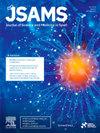Increase of circulating cell free mitochondrial DNA in amateur boxers after sparring matches
IF 3
2区 医学
Q1 SPORT SCIENCES
引用次数: 0
Abstract
Objectives
To determine if circulating mitochondrial deoxyribonucleic acid levels increase after sport activity involving blows to the head, such as boxing, and if it could play a role in inflammatory cascade regulation in response to trauma.
Design
Observational, longitudinal.
Methods
We measured mitochondrial deoxyribonucleic acid levels and integrity in ten non-professional male boxers before and after three weekly sparring matches. We set up a protocol to separate three different plasma fractions enriched in mitochondria-containing vesicles, mitochondrial deoxyribonucleic acid bound to proteins and naked mitochondrial deoxyribonucleic acid. We quantified the levels of the main cytokines involved in inflammatory response and the levels of neurofilament light, a well-known marker of brain damage.
Results
Circulating mitochondrial deoxyribonucleic acid levels increased after each match. In the second fraction, we also observed an increase over the weeks. Mitochondrial deoxyribonucleic acid is less intact after each match if compared with pre-match integrity, especially the naked form which is not protected within vesicles or mitochondria. Circulating levels of interleukin-6, interleukin-1beta and interleukin-10 increased after each match linking traumatic brain injuries to inflammatory state. Neurofilament light chain showed a similar trend to mitochondrial deoxyribonucleic acid.
Conclusions
As mitochondrial deoxyribonucleic acid displays an inflammatory effect and neurofilament light chain is more specific for brain injury, we concluded that the simultaneous analysis of these two parameters could be helpful to monitor the effects of traumatic brain injury in contact sports, and that mitochondrial deoxyribonucleic acid is a promising candidate biomarker to study the inflammatory state of patients who suffered repeated traumatic brain injuries.
业余拳击手拳击比赛后循环细胞游离线粒体DNA的增加。
目的:确定循环线粒体脱氧核糖核酸水平是否在涉及头部打击的体育活动(如拳击)后增加,以及它是否可能在创伤反应的炎症级联调节中发挥作用。设计:观察性、纵向研究。方法:对10名非职业男性拳击手每周3次对打比赛前后的线粒体脱氧核糖核酸水平和完整性进行了测定。我们建立了一个分离三种不同血浆组分的方案,这些血浆组分分别富含含线粒体囊泡、与蛋白质结合的线粒体脱氧核糖核酸和裸线粒体脱氧核糖核酸。我们量化了参与炎症反应的主要细胞因子的水平和神经丝光的水平,神经丝光是众所周知的脑损伤标志。结果:每次配型后循环线粒体脱氧核糖核酸水平升高。在第二部分,我们也观察到数周内的增长。线粒体脱氧核糖核酸在每场比赛后的完整性都不如赛前完整,特别是在囊泡或线粒体内不受保护的裸形式。白细胞介素-6,白细胞介素-1 β和白细胞介素-10的循环水平在每次比赛后增加,将创伤性脑损伤与炎症状态联系起来。神经丝轻链表现出与线粒体脱氧核糖核酸相似的趋势。结论:由于线粒体脱氧核糖核酸具有炎症作用,而神经丝轻链对脑损伤的特异性更强,我们认为同时分析这两个参数有助于监测接触性运动中创伤性脑损伤的影响,线粒体脱氧核糖核酸是研究反复创伤性脑损伤患者炎症状态的一个有希望的候选生物标志物。
本文章由计算机程序翻译,如有差异,请以英文原文为准。
求助全文
约1分钟内获得全文
求助全文
来源期刊
CiteScore
7.40
自引率
10.00%
发文量
198
审稿时长
48 days
期刊介绍:
The Journal of Science and Medicine in Sport is the official journal of Sports Medicine Australia (SMA) and is an an international refereed research publication covering all aspects of sport science and medicine.
The Journal considers for publication Original research and Review papers in the sub-disciplines relating generally to the broad sports medicine and sports science fields: sports medicine, sports injury (including injury epidemiology and injury prevention), physiotherapy, podiatry, physical activity and health, sports science, biomechanics, exercise physiology, motor control and learning, sport and exercise psychology, sports nutrition, public health (as relevant to sport and exercise), and rehabilitation and injury management. Manuscripts with an interdisciplinary perspective with specific applications to sport and exercise and its interaction with health will also be considered.

 求助内容:
求助内容: 应助结果提醒方式:
应助结果提醒方式:


